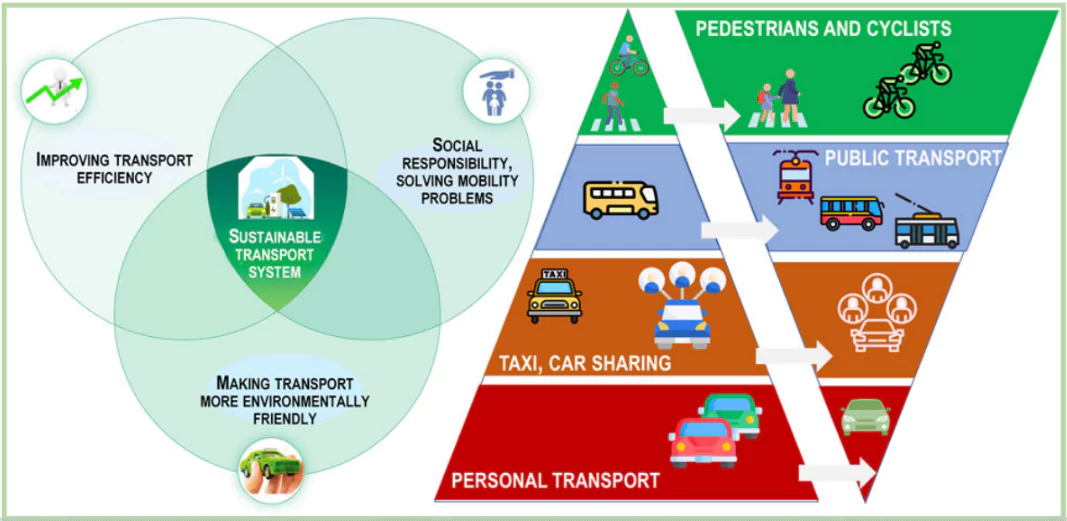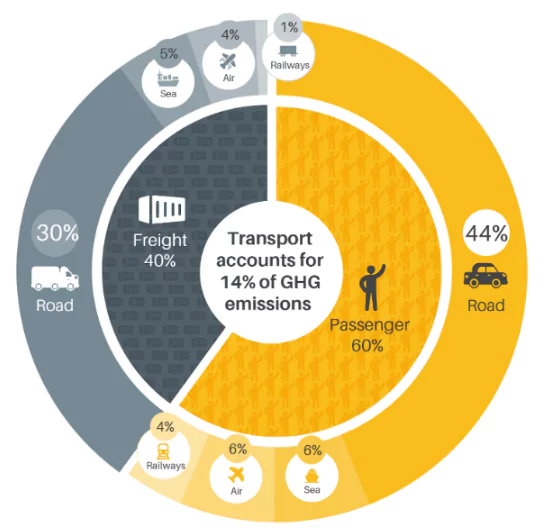A mission on Sustainable Transport will be added to the National Action Plan for Climate Change (NAPCC).
- The mission’s addition will mark the first inclusion in the NAPCC since its launch.
About National Action Plan on Climate Change (NAPCC)
- NAPCC outlines a national mitigation and adaptation strategy with 8 national missions in order to deal with the adverse effects of climate change and enable the ecological sustainability of India‘s development path.
- The National Action Plan on Climate Change (NAPCC) was launched in 2008.
- Missions:
- National Solar Mission: To focus on setting up an enabling environment for solar technology penetration in the country both at a centralized and decentralized level.
- Target: 100GW of Installed solar power capacity till 2022.
- National Mission for Enhanced Energy Efficiency: It aims to strengthen the market for energy efficiency by creating conducive regulatory and policy regime
- Initiatives: Perform, Achieve and Trade (PAT); Market Transformation for Energy Efficiency (MTEE); Energy Efficiency Financing Platform (EEFP); Framework for Energy Efficient Economic Development (FEEED)
- National Mission on Sustainable Habitat: Development of sustainable habitat standards that lead to robust development strategies while simultaneously addressing climate change related concerns
- National Water Mission: To ensure integrated water resource management to conserve water, minimize wastage and ensure more equitable distribution both across and within states
- National Mission for Sustaining the Himalayan Eco-system: It sets the goal to prevent melting of the Himalayan glaciers and to protect biodiversity in the Himalayan region.
- National Mission for a Green India: It aims at responding to climate change by a combination of adaptation and mitigation measures by enhancing ecosystem services
- National Mission for Sustainable Agriculture: It aims at making agriculture more productive, sustainable, remunerative and climate resilient
- National Mission on Strategic Knowledge for Climate Change: It aims to build a vibrant and dynamic knowledge system informing and supporting national action for responding effectively to the objective of ecologically sustainable development.
|
About The Mission on Sustainable Transport
- Objective: The new mission aims to address vehicular emissions and develop green policies in the overall transport sector to achieve net-zero targets.
- Sectoral Focus: The mission will focus on sector specific initiatives and policies for sub-sectors such as road transport, railways, ports, shipping and civil aviation.
- Nodal Ministry: The Ministry of Road Transport and Highways (Morth) is the nodal ministry which will collaborate with Indian Railways, MoCA (civil aviation), and the Ministry of Shipping.
- Factors: The mission will focus on factors like changes in logistics, design of roads and vehicles, laws, consumer behaviour, urban planning, setting emission standards aligning with international norms and alternative fuels and electric vehicles.
- Sectoral Measures:
-
- Focus on Road Transport Sector: The mission will especially focus on road transport emission standards and reductions and include new standards like BS-VII, besides shifting to alternative fuels and electric vehicles (EVs).
- The government has set a target for EVs to constitute 30% of the new private vehicle registrations by 2030.
- Railways: To achieve the Ministry of Railways target of net-zero carbon emitter by 2030, mainly through the electrification of operations and adding renewable energy to its core power source.
- Civil Aviation: The plan for the aviation sector will broadly align with existing international standards of transition to net-zero emissions by 2050, specified by International Civil Aviation Organization (ICAO)
- The ICAO intends to reduce carbon dioxide emissions by 5 per cent by 2030 through use of cleaner energy.
- The ICAO is also planning to introduce the Carbon Offsetting and Mitigation Scheme for International Aviation
- Carbon Offsetting and Mitigation Scheme: It is a market-based measure for offsetting any increase in carbon dioxide emissions beyond a baseline level.
- Shipping: The International Maritime Organization has already agreed on a net-zero framework by 2050 and will guide the ports ministry’s efforts in the area.
- The shipping industry plans to impose the first global carbon levy on vessels.
About Sustainable Transport
- Sustainable transportation refers to safe modes of transportation that have a low impact on the environment by using renewable sources instead of fossil fuels.
- Examples:
- Alternative Fuels: Biofuels, hydrogen fuel cells, and natural gas can provide alternatives to fossil fuels for vehicles.
- Electric Vehicles: The adoption of Electric vehicles along with growth in charging infrastructure density.
- Public Transport: The increased usage of public transport systems like BRTS, Metros, Zero Emission Buses, trams, e-rikshaws etc

- Contribution of Transport Sector to Emissions:
 Air Pollution: Transport is the fastest-growing source of energy-related carbon emissions contributing between 12 and 70% of urban air pollution as per World Bank.
Air Pollution: Transport is the fastest-growing source of energy-related carbon emissions contributing between 12 and 70% of urban air pollution as per World Bank.- India: India’s transport sector contributes approx 375 million tonnes of direct carbon dioxide emissions, which is ~10% of India’s total greenhouse gas emissions.
- Road Transport: It accounts for almost 90% of all transport emissions and is the largest contributor to pollution in India, accounting for about 12% of the country’s carbon dioxide emissions.
Need For Sustainable Transport
- Reduced Energy Dependence: Sustainable transport often involves energy-efficient options, such as electric vehicles or improved fuel efficiency in public transport reducing dependence on fossil fuels preventing pollution.
- The share of coal in India’s total energy generation increased to 79% to 16,906 petajoules(PJ) in 2023-24, about two percentage points more than the previous year, according to data from MoSPI’s Energy Statistics in India 2025.
- Increased Accessibility and Mobility: Sustainable transport systems improve accessibility for people by reducing congestion to essential services such as healthcare, education, and employment leading to a more productive and economically active population.
- Example: India plans to deploy 50,000 electric buses by 2030, with 10,000 electric buses to be introduced in over 100 cities.
- Reduced Emissions: These transport systems include shift to electric and hybrid vehicles, use of alternative green fuels, white coating of roads, using low-emission public transport etc helps to reduce greenhouse gas emissions crucial in mitigating climate change.
- Example: A WRI study showed that use of public transport can reduce greenhouse gas emissions by up to two-thirds per passenger per kilometre compared to private vehicles.
- Improved Air Quality: The usage of public transport systems which run on renewable electricity will lead to a reduction in air pollution and have immediate health benefits by lowering the incidence of respiratory diseases and related healthcare costs.
- Reducing Congestion: Public transport systems, such as buses, trams, subways, and commuter trains, have higher passenger capacities to move more people in a smaller space, reducing traffic congestion.
- Example: The launch of Delhi Metro has significantly reduced traffic congestion and led to marginal improvement in air pollution levels.
Challenges To Sustainable Transport Implementation
- The Road Challenge: There is still no internationally agreed-upon net-zero plan for the road transport sector which is a major emission source unlike in shipping and aviation sector.
- Example: The international shipping and aviation sectors aim to transition to net-zero emissions by 2050.
- The EV Challenge: Existing problems related to technology, charging infrastructure, investment, finances and marketing has made transition to EV quite difficult and delayed.
- Example: EVs are penetrating the market at a growth rate of 200 basis points per year and the required rate is nearly double to reach the 2030 target.
- High Cost of Infrastructure: New infrastructure such as pedestrian-friendly streets, public transportation systems, expanding rail network, alternative fuels etc would require huge investment which is a challenge for developing countries perpetuating existing challenges.
- India will require an investment of USD 2.2 trillion for infrastructure development to become USD 7 trillion economy by 2030, Knight Frank India Report
- Increased Electronic Waste: Technology based Smart and Sustainable transport systems like EVs and hybrid vehicles will leads to increased resource consumption, including electronic waste generation and energy usage.
- Example: India has generated 49.88 Lakh metric tonnes of electronic waste since 2022 and recycled just 2,570.26 metric tonnes of lithium-ion waste batteries
- Changing Consumer Behaviour: Underdeveloped, unreliable, or inaccessible public transport systems forces people to rely on private vehicles, exacerbating congestion and pollution.
- Example: The Namma Metro (Bengaluru) has seen a notable decrease in traffic congestion due to increased public transport usage, especially in areas with high traffic.
- Encroachments: Rapid urbanization leads to congested and encroached roads resulting in traffic jams and longer commute times.
- Optimizing Freight: Integrating different modes of transport like rail, truck, and ship into a single, coordinated supply chain requires huge operational and logistics efficiency.
Case Study: Sustainable Transportation Practices
- Netherlands: The Netherlands adopts a comprehensive approach that includes electrification, cycling infrastructure, and innovative public transport solutions.
- Electric Trains: All electric passenger trains in the Netherlands have been powered by green energy since 2017.
- Zero Emission Buses: All new buses to use 100% renewable energy or fuel from 2025 onwards, with a goal for all buses to be fully emission-free by 2030.
- Cycling Infrastructure: The Netherlands is renowned for its extensive and well-maintained cycling paths, promoting cycling as a primary mode of transport.
- Sweden: Sweden aims to achieve net-zero emissions by 2045, with ongoing projects to reduce carbon emissions from public transport.
- Renewable Energy: Since 2017, all trains and buses in Stockholm have been using 100% renewable energy.
- ElectriCity Project: In Gothenburg, the ElectriCity project tests new solutions for sustainable public transport, including electric buses.
- Luxembourg: Since 2020, Luxembourg has offered free public transport on all trains, buses, and trams to encourage public transport over private cars.
- France: It has developed a high-speed rail network and implemented policies to reduce fossil fuel use in transport.
- High-Speed Rail: France’s TGV network efficiently connects urban and rural areas, reducing the need for car travel.
- Fuel Tax and EV Incentives: The government has implemented a fuel tax to discourage fossil fuel use and offers incentives for purchasing electric vehicles.
|
Way Forward
- Efficient Logistic Model: It involves transitioning from primarily road transportation to a combination of rail and water transport for long-distance shipments making it cost-effective, energy-efficient, and environmentally friendly.
- Example: Several European countries like Netherlands, Germany, and Denmark, consistently rank high in terms of logistics performance, particularly in intermodal freight transport.
- Smart Mobility Solutions: It encompasses introducing rapid transit systems (Bus Rapid Transit (BRT) or Metro Rail) and innovative technologies such as contactless payment systems, real-time passenger information, and integration with other modes of transportation like bike-sharing systems.
- Example: London has introduced the Oyster Card system, used for pay-as-you-go travel on public transportation.
- Electric Vehicles and Electric Vehicle Infrastructure: Promoting Electric Vehicle adoption by giving tax exemptions and other incentives and building EV infrastructure necessitating the shift is a crucial step in the road to sustainable transport.
- Example: Norway is a global leader in adopting electric vehicles (EVs) and provides incentives like free access to EVs charging points and tolls to promote green transport.
- Road Engineering and Urban planning: Urban planning centered around sustainable transport principles will result in a public transport system that is compact, transit-oriented and non-motorized transport focused.
- Example: Singapore’s Integrated Transportation System has integrated various modes of public transport, including buses, trains, and trams, into a seamless network resulting in reduced congestion and pollution.
- Sustainable/alternative Fuel for Cargo Transport: To shift from the traditional fossil fuel based fuels to a greener alternative like biofuels, methanol, liquefied natural gas (LNG), CNG, hydrogen across all the transportation sectors at an accelerated pace.
- Example: India is gearing up to set a new target of 30% ethanol blending in petrol by 2030, having already achieved a 20% blend in 2025.
- Regulation: Government regulations need to promote the adoption of sustainable transportation activities like establishing emissions standards, promoting public transport, and encouraging alternative fuels, financing Electric vehicles etc.
- Example: India adopted the Bharat Standard based on the European Union Standards.
Indian Government Initiatives for Sustainable Transport
- Electric Vehicle (EV) Promotion:
- FAME India Scheme: The scheme provides subsidies to promote the adoption of electric vehicles, including buses, three-wheelers, and electric taxis.
- National Electric Bus Program (NEBP): This program aims to deploy 50,000 electric buses across Indian cities by 2030.
- Tax Exemptions: Lithium has been fully exempted from customs duties which will enhance the EVs affordability and accessibility.
- Transit Oriented Development: To create compact, walkable communities centered around high-quality public transport systems to maximise accessibility and reduce reliance on private vehicles, and promote sustainable urban growth.
- Metro Rail Expansion: Metro systems are expanding in major cities, providing clean and efficient alternatives to car-based commutes.
- PM GatiShakti National Master Plan (NMP): It focuses on multi-modal connectivity across highways, railways, ports, airports, and logistics infrastructure to promote green logistics and clean energy goals.
- National Rail Plan: The plan aims to boost Indian Railways’ freight share to 45% by 2030, recognizing the environmental advantages of railways. The railways have set a Net Zero target of 2030.
|
Conclusion
The Inclusion of a Mission on Sustainable Transport in NAPCCC is a step in the right direction which will put necessary focus on mitigating the transport sector emissions as well as provide with safe, sustainable, efficient and climate friendly accessible mobility options.
![]() 4 Jun 2025
4 Jun 2025


 Air Pollution: Transport is the fastest-growing source of energy-related carbon emissions contributing between 12 and 70% of urban air pollution as per World Bank.
Air Pollution: Transport is the fastest-growing source of energy-related carbon emissions contributing between 12 and 70% of urban air pollution as per World Bank.